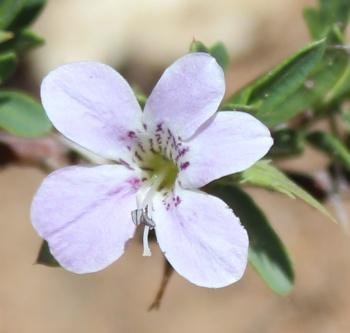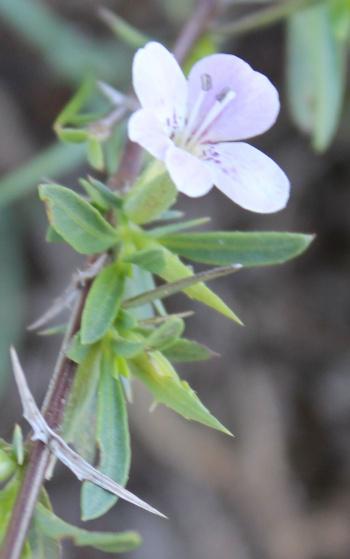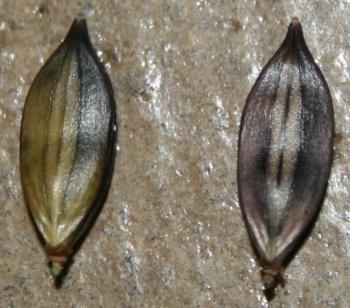Barleria virgula
Barleria virgula C.B.Clarke
Family: Acanthaceae
Common names: sand bush violet (Eng.); sandbosviooltjie (Afr.)
Introduction
‘The drier I get, the better I flower!’

Description
Description
Barleria virgula is a slender shrublet up to 300 mm high. The stems grow out of a woody rootstock. Older stems are woody and reddish in colour and covered with simple white hairs. The leaves are opposite, linear, with scattered hairs on the midrib; margins entire; petiole short, with narrowed leaf tips. Flowers solitary in the leaf axils (angle between the stem of the plant and the leaf stem), mauve, with purple markings in the throat. The corolla (flower petals) is 2-lipped, upper lip 4-lobed and lower lip entire. Corolla tube yellow. Each flower is subtended by modified leaves called calyx lobes .The calyx lobes are elliptic; margins spiny, toothed and apex ends in a sharp point. The secondary bracts are called the bracteoles; they are lanceolate, thorny like and situated at the base of each flower. Plants flower in late summer, autumn and winter, from February to June, during which time flowers appear sporadically.

The seed capsules are elliptic, with a short beak. When the ripe capsule becomes moist, they burst open to distribute the seeds. There are 4 seeds per capsule.

Conservation Status
Status
According to the Red List of South African Plants Barleria virgula is assessed as Least Concern (LC).

Distribution and habitat
Distribution description
Barleria virgula grows in open woodland and bushveld areas. It grows naturally in the Limpopo, Mpumalanga and Gauteng Provinces and Zimbabwe. It grows in sandy and sandy-loam soils, in sunny conditions. It tolerates mild frost and is a water-wise plant.

Derivation of name and historical aspects
History
The genus name Barleria is derived from the name of a Dominican monk and French botanist, Jacques Barrelier (1606–1673). The species name virgula, means ‘little twig’ or ‘wand’.
The genus Barleria consists out of a group of herbs, subshrubs and shrubs, some producing spines and all producing fruit in the form of explosive capsules. The genus includes popular garden plants such as the pink flowering Barleria repens and mauve flowering B. obtusa. This species can be recommended as a garden subject on rockeries, sunny patches and to effectively combat soil erosion.
Ecology
Ecology
Barleria virgula is pollinated by insects and attracts various species of butterflies.
Uses
Use
Barleria virgula is recommendable as a water-wise plant for the garden. It flowers in abundance especially when watering is minimized. Too much water stimulates vegetative growth and less flower production.
Growing Barleria virgula
Grow
Barleria virgula can easily be propagated from seed or cuttings. Harvest the ripe seed capsules when turning brown. Use 1 part river sand and 2 parts potting mix, as a growing medium for germination. Plant the seeds 2 cm apart in a tray and cover them lightly with the growing medium. Place the tray with seeds in a shady spot and water well once a week. Germination starts to take place in a week. Transplant the seedlings when 10 cm in size.
Semi-hard plant material is the best for cuttings. Cut the cuttings in lengths of 10 cm. The most effective mixture to root the cuttings in is 1 part of coarse river sand and 2 parts potting mix. Treat the cuttings with a rooting hormone and plant the cuttings 5 cm apart in a container. Place the container in a shady spot and water twice a week. Transplant the rooted cuttings after 4 months in a good potting mixture. Expect a success rate of 70%. There are no specific pests or diseases that affect Barleria virgula.
References
- Flora capensis entry for Barleria virgula, accessed via JSTOR Global Plants: Plants.jstor/stable/10.5555/al.ap.flora.floc011433
- Little, J. R. & Jones, C.E. 1980. A dictionary of botany. Van Nostrand Reinhold Compony, New York, Cincinnatti, Toronto, Melbourne.
- Raimondo, D. et al. 2009. Red list of South African plants. Strelitzia 25. SANBI (South African National Biodiversity Institute), Pretoria.
- Retief, E. & Herman, P.P.J. 1997. Plants of the northern provinces of South Africa: keys and diagnostic characters. Strelitzia 6. National Botanical Institute, Pretoria.
- Stearn, W.T. 2004. Botanical Latin. Timber Press, Oregon.
Credits
Willem Froneman
Lowveld National Botanical Garden
March 2017
Plant Attributes:
Plant Type: Shrub
SA Distribution: Gauteng, Limpopo, Mpumalanga
Soil type: Sandy, Loam
Flowering season: Late Summer, Autumn, Winter
PH: Acid, Neutral
Flower colour: Purple, Yellow, Mauve/Lilac
Aspect: Full Sun
Gardening skill: Average
Special Features:
Horticultural zones











Rate this article
Article well written and informative
Rate this plant
Is this an interesting plant?
User Comments
Mark Suster, South Africa
March 17, 2017 at 9:03 PMWhat an utterly stunning Acanthaceae!!!
Thank you for your excellent information. As a pensioner botany has since become an avid hobby of me and my wife. I just booked a trip to South Africa on accommodirect.com and sanparks.org and am absolutely ecstatic to be able to see, breathe and experience the diverse and wonderful flora of South Africa.
- Mark
Login to add your Comment
Back to topNot registered yet? Click here to register.